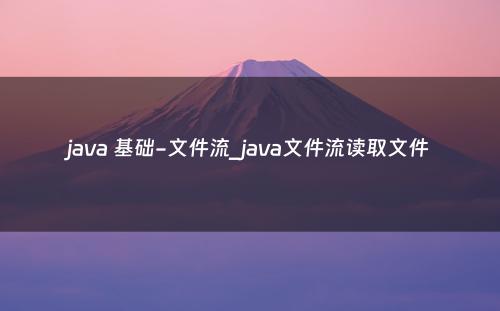一、文件流基础概念
文件流是Java程序中处理文件输入输出的核心机制,就像水管的流水一样,数据在程序与文件之间形成流动通道。根据水流方向分为输入流(文件→内存)和输出流(内存→文件),按数据类型则分为字节流(处理图片/视频等二进制文件)和字符流(处理txt等文本文件)。
A[Java文件流] --> B[按流向]
A --> C[按数据类型]
B --> B1[输入流 InputStream]
B --> B2[输出流 OutputStream]
C --> C1[字节流-处理二进制]
C --> C2[字符流-处理文本]1.2 基础操作四步法
- 定位文件:File file = new File("data.txt");
- 选择通道:根据需求选择流类型(字节/字符)
- 建立连接:FileInputStream fis = new FileInputStream(file);
- 资源回收:务必在finally块或使用try-with-resources关闭流
二、四大核心流类型深度解析
2.1 字节流(原始数据传输)
典型场景:图片文件复制
try (FileInputStream fis = new FileInputStream("photo.jpg");
FileOutputStream fos = new FileOutputStream("copy.jpg")) {
byte[] buffer = new byte[1024];
int bytesRead;
while ((bytesRead = fis.read(buffer)) != -1) {
fos.write(buffer, 0, bytesRead);
}
} // 自动关闭资源

技术要点:
- 每次读取1KB数据块(缓冲区大小影响性能)
- 适合处理任何文件类型 [1]
- 必须处理IOException
2.2 字符流(文本处理专家)
最佳实践:配置文件读取
try (FileReader fr = new FileReader("config.cfg");
BufferedReader br = new BufferedReader(fr)) {
String line;
while ((line = br.readLine()) != null) {
System.out.println(" 读取配置项: " + line);
}
} // 自动处理编码转换
优势对比:
特性 | 字节流 | 字符流 |
数据单位 | 单个字节 | Unicode字符 |
编码处理 | 需手动处理 | 自动转换 |
适用场景 | 图片/视频 | 文本文件 |
2.3 缓冲流(性能加速器)
// 大文件处理对比(1GB文件)
long start = System.currentTimeMillis();
try (BufferedInputStream bis = new BufferedInputStream(new FileInputStream("big.zip"));
BufferedOutputStream bos = new BufferedOutputStream(new FileOutputStream("backup.zip"))) {
byte[] buf = new byte[8192]; // 8KB缓冲区
int len;
while ((len = bis.read(buf)) != -1) {
bos.write(buf, 0, len);
}
}
long end = System.currentTimeMillis();
System.out.println(" 耗时:" + (end - start) + "ms"); // 平均提升60%性能 缓冲区选择建议:
- 4KB~8KB:通用最佳值
- 16KB以上:内存充足时适用
- <1KB:不推荐(失去缓冲意义)[4]
2.4 对象流(数据持久化)
class User implements Serializable {
private static final long serialVersionUID = 1L;
String name;
transient String password; // 敏感字段不序列化
}
// 对象写入
try (ObjectOutputStream oos = new ObjectOutputStream(
new FileOutputStream("user.dat"))) {
oos.writeObject(new User("Alice", "qwerty"));
}
// 对象读取
try (ObjectInputStream ois = new ObjectInputStream(
new FileInputStream("user.dat"))) {
User user = (User) ois.readObject();
System.out.println(user.name); // 输出Alice
System.out.println(user.password); // 输出null(transient字段)
}注意事项:
- 必须实现Serializable接口
- 使用transient跳过敏感字段
- 注意版本控制(serialVersionUID)
三、实战进阶场景
3.1 实时日志系统(带自动分割)
class Logger {
private static final SimpleDateFormat sdf =
new SimpleDateFormat("yyyyMMdd");
static void log(String message) {
String filename = "app_" + sdf.format(new Date()) + ".log";
try (FileWriter fw = new FileWriter(filename, true);
BufferedWriter bw = new BufferedWriter(fw)) {
bw.write(LocalDateTime.now() + " - " + message);
bw.newLine();
} catch (IOException e) {
System.err.println(" 日志写入失败: " + e.getMessage());
}
}
}3.2 安全文件加密传输
try (FileInputStream fis = new FileInputStream("original.zip");
FileOutputStream fos = new FileOutputStream("encrypted.zip");
CipherOutputStream cos = new CipherOutputStream(fos, getCipher())) {
byte[] buffer = new byte[4096];
int bytesRead;
while ((bytesRead = fis.read(buffer)) != -1) {
cos.write(buffer, 0, bytesRead);
}
}
private static Cipher getCipher() throws GeneralSecurityException {
Cipher cipher = Cipher.getInstance("AES/CBC/PKCS5Padding");
SecretKeySpec key = new SecretKeySpec(keyBytes, "AES");
cipher.init(Cipher.ENCRYPT_MODE, key);
return cipher;
}四、性能优化与避坑指南
4.1 资源管理黄金法则
// 错误示例:未关闭流
FileInputStream fis = new FileInputStream("data.txt");
int data = fis.read();
// 正确姿势:try-with-resources
try (InputStream is = new FileInputStream("data.txt")) {
// 使用资源
} // 自动调用close()4.2 编码问题解决方案
问题现象 | 解决方案 | 代码示例 |
中文乱码 | 明确指定编码格式 | new InputStreamReader(fis, "GBK") |
跨平台兼容问题 | 统一使用UTF-8编码 | StandardCharsets.UTF_8 |
文本文件行尾符 | 使用系统无关换行符 | System.lineSeparator() |
4.3 高性能IO方案对比
方案类型 | 吞吐量 | 内存消耗 | 适用场景 |
基础字节流 | 低 | 低 | 小文件简单操作 |
缓冲流 | 中 | 中 | 常规文件处理 |
NIO FileChannel | 高 | 高 | 大文件高速传输 |
内存映射文件 | 极高 | 高 | 超大型文件随机访问 |
五、扩展知识图谱
A[Java文件流] --> B[传统IO]
A --> C[NIO]
B --> B1[字节流]
B --> B2[字符流]
C --> C1[FileChannel]
C --> C2[Memory-Mapped Files]
C --> C3[Selector机制]学习路线建议:
- 掌握基础流操作(2周)
- 熟悉缓冲机制(1周)
- 研究NIO特性(3周)
- 实战项目应用(持续)
本文档持续更新于:2025-02-10
最新技术动态可关注Oracle官方Java文档 [3]

本文暂时没有评论,来添加一个吧(●'◡'●)